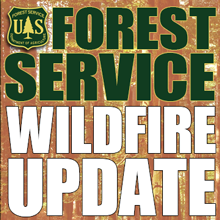
Thunderstorms and winter rain events in the Sierra Nevada and Cascade mountains can result in high runoff and flooding.
Wildfire increases the potential for flooding, post-fire soil erosion and debris flows that could impact campgrounds, fishing areas, homes, structures, roads, and other infrastructure within, adjacent to, and downstream from the burned areas.
Post-fire, watershed conditions will naturally receive and transport water and sediment differently than during pre-fire conditions.
The public and communities adjacent to and downstream from the wildfire areas should expect increased flooding and debris transport during less than average rain events.
The potential for increased runoff and debris flows are not just a one-year concern.
We need to recognize the threat potential of flash floods and debris flows may exist for the next several years, depending on the intensity of these storms.
For life and safety concerns, burned area closures may need to be implemented prior to forecast rain events until the burned area fully recovers.
Residents and visitors should remain alert to weather events and plan ahead when travelling along roads within and downstream from the burned areas of the Dixie wildfire.
A Burned Area Emergency Response team has been working with the Lassen and Plumas National Forests, to assess the condition of the watersheds on National Forest System (NFS) land burned in the Dixie wildfire.
The BAER assessment team identifies potential emergency threats to critical BAER values, and recommends emergency stabilization response actions that are implemented on federal land to reduce potential post-fire threats.
BAER critical values that may be considered at-risk on federal lands are:
- Human life and safety.
- Property such as buildings, water systems and infrastructure, utility systems, road and trail prisms.
- Critical natural resources such as water, soil productivity and hydrologic function, areas where invasive species or noxious weeds may impact native or naturalized communities and may include critical habitat or suitable occupied habitat for federally listed threatened or endangered species.
- Critical cultural and heritage resources such as pre-historic and historic properties and sites.
For values and resources potentially impacted off federal lands, one of the most effective BAER strategies is interagency coordination with local cooperators who assist affected businesses, homes, and landowners with preparing for rain events.
While multi-agency efforts are being taken to reduce the risks to life and safety adjacent to and downstream from the burned areas, nearby residents should develop individual plans to protect themselves and their property.
The Forest Service and Natural Resources Conservation Service work together and coordinate with other federal, state and local agencies, and counties that assist private landowners in preparing for increased run-off and potential flooding impacts.
NRCS and local sponsors prepare damage survey reports for eligible sites on private lands adjacent to and downstream from affected areas. NRCS uses these reports, along with the Forest Service BAER team’s assessment report, to develop emergency measures to reduce the impacts from potential increased water and debris flows, and assist local sponsors to implement recommended emergency measures through its Emergency Watershed Protection Program.
All EWP Program–Recovery projects begin with a local sponsor or legal subdivision of state or tribal government. Eligible sponsors include cities, counties, towns, conservation districts, or any federally-recognized Native American tribe or tribal organization. Interested public and private landowners can apply for EWP Program–Recovery assistance through one of those sponsors.





